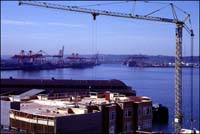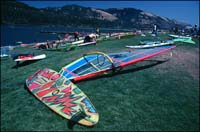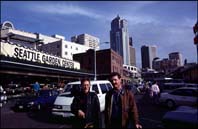GEOG 332 - Analytical Exercise
Winds of Change in the Pacific Northwest
Instructions and Requirements
For larger versions of photos, click on image.
Introduction
One of the main ideas in this course that should be deeply etched in your minds by this time in the semester is that regions come about from the convergence of numerous dynamic processes operating in a particular location. The economic structure of an area is an aspect of regional formation to which we have paid particular attention throughout this course. Since a significant component of regional character derives from the various ways people attempt to make a living, changes in the spatial economic patterns of a region will affect the non-economic components of regional identity.
 In this exercise you will
examine employment trends for selected counties in Oregon. However, many
of these trends are echoed in Washington and northern California. Forestry
was the first major industry in the Pacific Northwest. At the turn of the century, there were
about 65,000 Oregonians working in sawmills, plywood plants, pulp and
paper manufacturing operations, logging and trucking companies, and wood
furniture manufacturing facilities. The forest products industry is among Oregon's
largest manufacturing employers. However, over the past several decades
the employment mix in Oregon has undergone significant change. For a variety
of reasons (including global competition, recession, and environmental
regulations), timber harvests have declined, resulting in a loss of jobs
at the same time that the population of the state has been growing. What,
if anything, are these new residents doing for a living? Of course, the
answer to this question depends upon where you look. This is a
geography course, after all. The data set you have for this exercise focuses
on counties that have demonstrated the most dramatic employment change
since 1970.
In this exercise you will
examine employment trends for selected counties in Oregon. However, many
of these trends are echoed in Washington and northern California. Forestry
was the first major industry in the Pacific Northwest. At the turn of the century, there were
about 65,000 Oregonians working in sawmills, plywood plants, pulp and
paper manufacturing operations, logging and trucking companies, and wood
furniture manufacturing facilities. The forest products industry is among Oregon's
largest manufacturing employers. However, over the past several decades
the employment mix in Oregon has undergone significant change. For a variety
of reasons (including global competition, recession, and environmental
regulations), timber harvests have declined, resulting in a loss of jobs
at the same time that the population of the state has been growing. What,
if anything, are these new residents doing for a living? Of course, the
answer to this question depends upon where you look. This is a
geography course, after all. The data set you have for this exercise focuses
on counties that have demonstrated the most dramatic employment change
since 1970.
Economic Activities and Employment
 Economic
geographers use a four category classification system to distinguish economic
activities. Primary activities are those involved in harvesting
or extracting resources from the earth. Agriculture, fishing, forestry,
and mining are examples of primary economic activities. Secondary
activities process the raw materials extracted by primary activities
transforming them into more usable and valuable commodities. Steel making,
milling logs, and fish processing are all examples of secondary activities.
Products from secondary activities can be used in other secondary activities.
For example, milled lumber is utilized by the construction industry and
steel is used by automobile manufacturers. Electrical power generation
is also a secondary activity.
Economic
geographers use a four category classification system to distinguish economic
activities. Primary activities are those involved in harvesting
or extracting resources from the earth. Agriculture, fishing, forestry,
and mining are examples of primary economic activities. Secondary
activities process the raw materials extracted by primary activities
transforming them into more usable and valuable commodities. Steel making,
milling logs, and fish processing are all examples of secondary activities.
Products from secondary activities can be used in other secondary activities.
For example, milled lumber is utilized by the construction industry and
steel is used by automobile manufacturers. Electrical power generation
is also a secondary activity.
 The remaining two categories involve
some kind of service rather than extraction or manufacturing of commodities.
Tertiary activities provide the link between the producer
and consumer. Wholesale and retail sales are examples of tertiary activities.
Also included in this category of economic activity are most tourism related
businesses, personal services, and business and professional services.
Finally, quaternary activities include education, government,
management, information processing, and research. Most "white collar"
occupations fall into this category. Underlying these four categories
is the transportation and communication infrastructure that links the
various sectors of economic activity.
The remaining two categories involve
some kind of service rather than extraction or manufacturing of commodities.
Tertiary activities provide the link between the producer
and consumer. Wholesale and retail sales are examples of tertiary activities.
Also included in this category of economic activity are most tourism related
businesses, personal services, and business and professional services.
Finally, quaternary activities include education, government,
management, information processing, and research. Most "white collar"
occupations fall into this category. Underlying these four categories
is the transportation and communication infrastructure that links the
various sectors of economic activity.
Another common method for understanding the impact of different types of employment on regions is to distinguish between basic and non-basic or service sectors of the economy. Basic sector employees are involved in the production of goods for export from the region. The effect is an in-flow of money to the region. Service or non-basic sector employees are responsible for the successful internal functioning of the region. They operate the stores, offices, government, and school systems.
This distinction between basic and non-basic sector employees is important because the ratio between the two categories changes as the population of an area increases. Specifically, as the population of a region increases, the number of new non-basic sector jobs grows faster than the number of new basic sector employees. In regions of 1 million, for example, the ratio is approximately 2 non-basic sector employees for every basic sector job. This phenomenon is referred to as a multiplier effect.
 The multiplier
effect becomes a critical concept if we consider how jobs and population
grow. A new enterprise in a region that manufactures goods for export
will generate new basic sector jobs. These new workers will need goods
and services such as food, medical care, and accountants. In turn, the
folks that perform these services will also need services available to
them. Grocery clerks must also buy groceries. Given the impact of the
multiplier effect, which type of employment is more beneficial when a
politician promises to create new jobs?
The multiplier
effect becomes a critical concept if we consider how jobs and population
grow. A new enterprise in a region that manufactures goods for export
will generate new basic sector jobs. These new workers will need goods
and services such as food, medical care, and accountants. In turn, the
folks that perform these services will also need services available to
them. Grocery clerks must also buy groceries. Given the impact of the
multiplier effect, which type of employment is more beneficial when a
politician promises to create new jobs?
 An important concept in the
analysis of economic growth and change is the threshold.
A threshold, in this case, is the minimum population necessary to support
a business enterprise or sector of the economy. This concept is particularly
important when we examine tertiary or service sector employment because
these activities are dependent on the population in the immediate area
for their viability. Factors that can effect the level of a threshold
include affluence of a population, and the number of desirable sites for
locating a business. Both of these factors increase in larger urban areas.
An important concept in the
analysis of economic growth and change is the threshold.
A threshold, in this case, is the minimum population necessary to support
a business enterprise or sector of the economy. This concept is particularly
important when we examine tertiary or service sector employment because
these activities are dependent on the population in the immediate area
for their viability. Factors that can effect the level of a threshold
include affluence of a population, and the number of desirable sites for
locating a business. Both of these factors increase in larger urban areas.
Finally, researchers have recognized that in advanced economies services can eventually replace industry as the principal sector of the economy. In postindustrial societies, professional and technical employment supersedes agriculture, resource extraction and manufacturing.
Data Set and Terminology
Most of the data for this exercise was derived from the County Business Patterns, an annual report by the U.S. Department of Commerce. The data in County Business Patterns for the study period are tabulated by Standard Industrial Classification (SIC) codes. Most of the economic divisions of the nation's economy are covered by these classifications including agriculture, mining, construction, manufacturing, transportation, public utilities, wholesale trade, retail trade, finance, insurance, real estate, and services. These main categories are further subdivided by specific industry. For example, under the general heading "manufacturing" one will find food, textiles, lumber, stone, electronics, transportation, etc. Each of these sub-categories is further subdivided for greater detail. We are only using data for the general levels in this exercise. If you would like to see a sample page from this data source, click here.
The variables in the data set DO NOT include all of the general categories of employment so the totals will not equal the sum of the other employees. Also, the figures for lumber are actually a sub-category of manufacturing. That is, the total for manufacturing includes the figure for lumber. In several instances you will find "N/A" instead of a specific value. This is usually because the figures have been withheld to avoid disclosing data for individual companies. It also might mean there were not any employees in the category.
It is important to note that government employees are not included in this data set. Also, independent contractors or consultants that do not work for a company are not included. For example, a freelance graphic artist or an independent carpenter are not counted.

Instructions and Detailed Questions
Submit your responses to the following questions in the form of a brief report entitled, "Economic Change in the Pacific Northwest." That typewritten packet does not need to repeat the detailed questions. A simple numbering of your responses will be adequate. Some may be answered with just a few numbers or a brief phrase. Others will require a paragraph or two of explanations. Do not submit the original data set or these instructions.
After carefully reviewing the tables, maps, and any other material you feel is appropriate, please answer the following:
1. On a thematic map, each place (in this case a county) which fits within a certain category of values is displayed by a color or pattern that distinguishes it from counties with higher or lower values on the same indicator. Here is an example of a thematic map. In this question, you will divide your counties into three or four groups based on where they stand in their "lumber intensity" (either total number of workers in the lumber industry or lumber workers as a percent of all workers in the county). Please create a thematic map of Oregon counties that shows varying degrees of "lumber intensity" in employment.
2. While timber jobs have declined overall in Oregon since 1970, not all counties have lost jobs at the same rate, or at all. Please identify a county that best represents each of the categories below and create a graph showing each county and the timing of employment change.
-
Relatively little change in proportion of timber jobs
-
Early decline
-
Recent decline
-
Steady decline
3. Oregon experienced a 52 percent increase in its population during the time period covered by the data set in this exercise. Two counties which had to deal with even stronger growth patterns were Josephine (101% increase) and Washington (138% increase). How did the economies in each of these two counties change (a) in terms of total employment and (b) major sectors of job growth? Why might "retailing" and the "services sector" of the two counties be different? Consider the total population size of the two counties, their location relative to nearby population centers, and/or any special regional conditions or special economic activities which might influence the specific "services" emphasized by each county. Consider the locations of Josephine and Washington relative to other population centers. What factors might have influenced the ways in which their employment mixes changed over time?
4. While some of the changes in employment may be obvious, please offer possible explanations for employment changes in the following counties.
-
Clackamas
-
Coos
-
Grant
-
Tillamook
5. Using the terms and concepts in the discussion above and from class lectures, please characterize Oregon's employment mix in the mid-90s. (one paragraph)
6. Respond to the following scenario: You have just landed a job as a manager in the Tillamook County government. In your new job, economic development is a high priority. What sectors of the economy would you try to improve? How might you go about this? Just a reminder, Highway 6 is a protected scenic highway and cannot be turned into a commuter freeway to Portland. (two paragraphs maximum)
Submission Requirements
At the top of the first page of your exercise include your name and the title, "Economic Change in the Pacific Northwest." You can submit your work via the link on the class Canvas site or as printed hard copy. If you choose to turn in a hard copy, please, no special covers or binders! Late papers are subject to grade penalties; they will be worth no more than 50 percent of the maximum available points.
Check your syllabus for due date and other details.
last updated 11/18/24